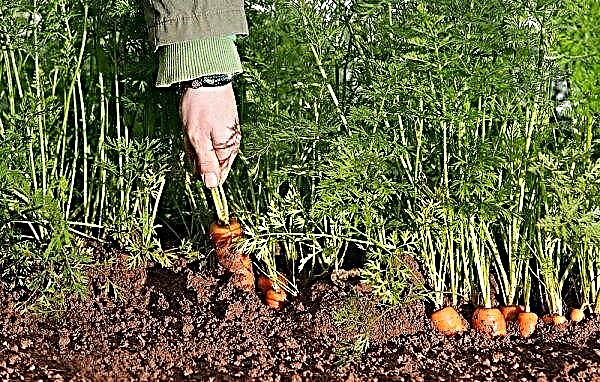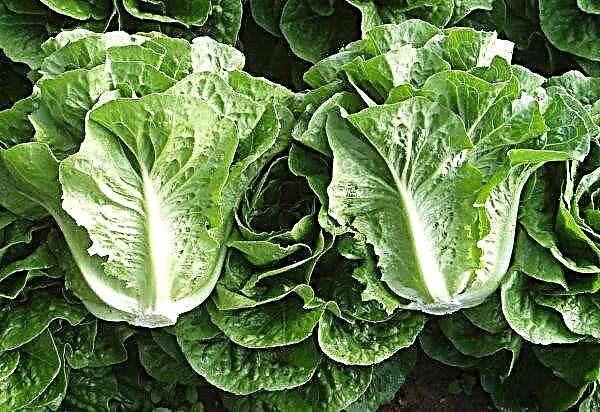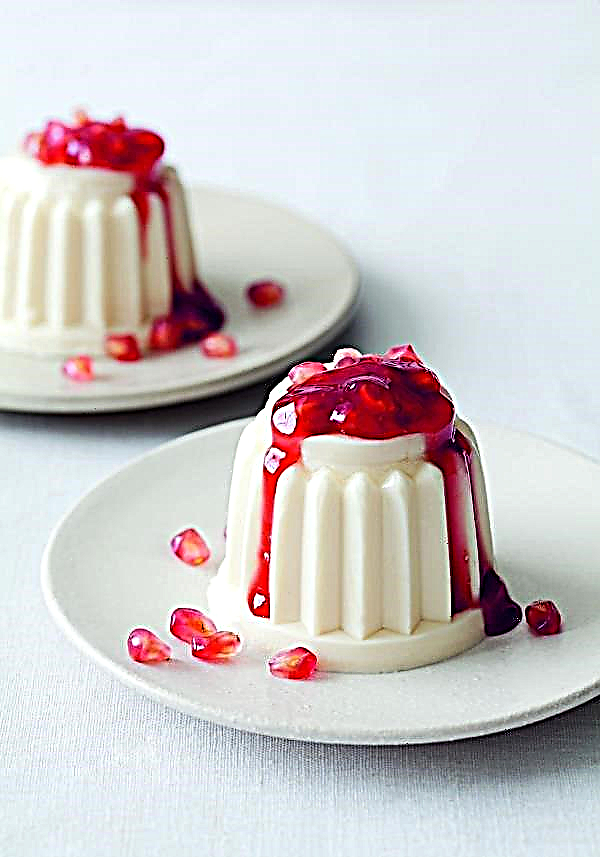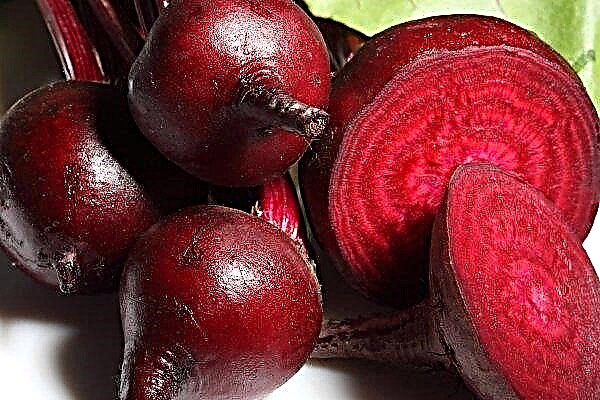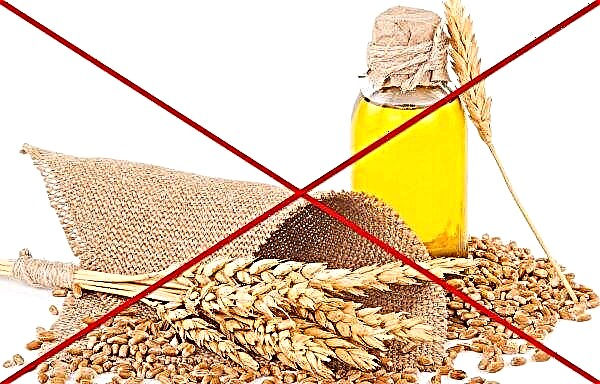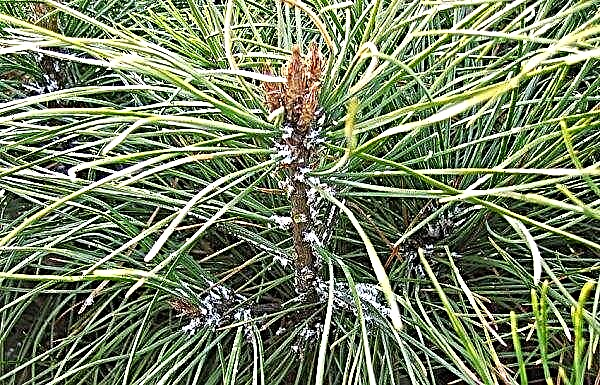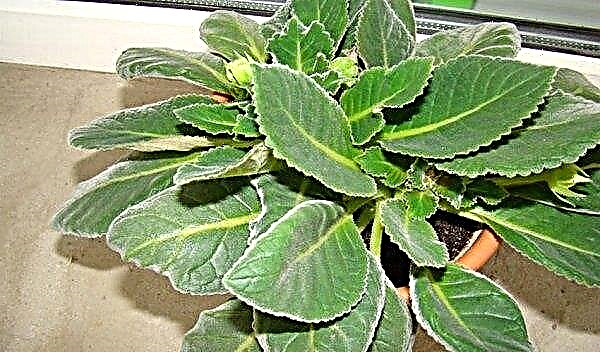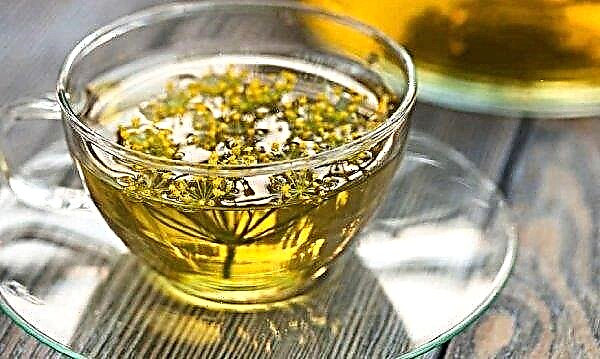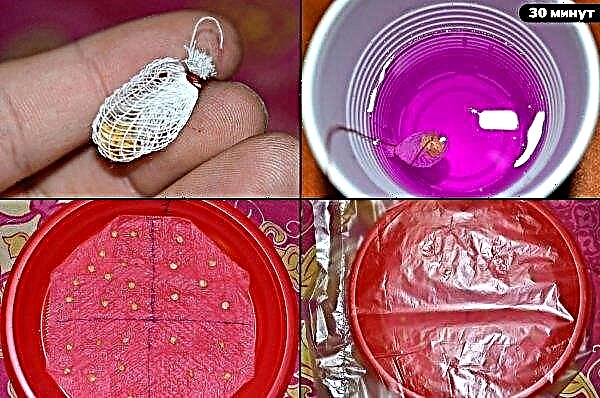Dracaena (colloquially dragon tree) is a plant from the Agave family that grows in nature in the warm and humid tropical forests of Asia, Africa and the Canaries. The room content of this false palm should correspond to the conditions of its natural habitat - only then will this plant feel good. The main requirement for growing is a suitable watering, it is on him that the well-being of the dragon tree depends.
Did you know? There are many types of dracaena - from small indoor to real giants, whose growth exceeds 20 m, and the trunk width in girth can reach 4 m.
Basic rules for growing and caring for dracaena
Dracaena, although it is a tropical plant, however, it is quite unpretentious for indoor maintenance. He likes warmth, moderate humidity and regular, but not too plentiful watering.
Such conditions are quite simple to arrange in the apartment, since home cultivation, regardless of the time of year, allows you to create the necessary air temperature for the palm.
Dracaena will grow healthy and beautiful if you follow the following rules in caring for it:
- The air should be warm. The temperature in the summer is from +20 to +25 ° С; for a short time, the dragon tree can tolerate higher temperatures. In winter, the temperature regime should not fall below the mark of +15 ° C.
- A false palm tree needs a lot of light, but it is afraid of direct sunlight, and dies in the shade. It is best to place a pot of dracaena on a window facing east or west, and you can also place it near the south window. Light loves plentiful, but diffused. In winter, it needs additional lighting, since the winter sun is not enough for her.
- To the soil, the plant is unpretentious and able to grow in any soil. However, it will feel best in loose, well-permeable soil with drainage.
- Dragon tree needs feeding only during the growing season, which lasts from April to August. At this time, it must be fed with complex mineral liquid fertilizers once every 2 weeks.
- Needs transplantation on average 1 time every 3 years. Young individuals can be transplanted once a year, and adults - once every 5 years.
- Almost all types of dracaena need high humidity, so you need to spray it as often as possible.
- Dracaena prefers regular watering and moist soil. However, an excess of moisture and its accumulation at the roots is dangerous for the plant - the root system rots, pests multiply, and the false palm dies. That is why it is better to under-fill the water than to allow its overabundance.
Did you know? The dragon tree sap has been nicknamed “Dragon Blood,” since the initially clear liquid in the air takes on a blood-red color and is very reminiscent of blood.
How many times and how often do you need to water dracaena
Dracaena loves water, but excess moisture is dangerous for it.
The frequency of watering depends mainly on the season and air temperature. So, if the air in the room is warm (over +20 ° C), then watering should be more frequent - 1-2 times during the week. The faster the soil dries up, the more frequent watering should be, so in hot weather you may need to water the flower and more often twice a week.

The main criterion that the time has come for watering is the dryness of the topsoil. It should dry 2-3 cm deep, but no more. If the top layer of the earth has dried up, become friable and does not stick to your fingers, then it is time to water the dracaena with water.
When building an irrigation scheme and determining the frequency and volume of liquid, the following conditions must be taken into account:
- if the topsoil dries more often than once a week or more than 3-5 cm, then watering should be done more often;
- if the topsoil has not dried out within a week, then you need to increase the intervals between irrigation and, possibly, reduce the amount of water;
- if water accumulates in a flowerpot above the surface of the soil, it means that it is necessary to reduce the volume of liquid.
With proper fluid flow, the plant looks great - with a lush foliage hat and bright coloring.
What water is better to use
Using tap water that has not undergone any treatment is undesirable. The water from the water supply is too chlorinated and hard, and therefore not too suitable for indoor plants. In addition, it contains salts and metals that contribute to the propagation of pathogenic bacteria in the pot.
For dracaena, soft neutral water is best suited:
- thawed;
- boiled;
- defended;
- rain;
- peeled.

However, the risk of using rainwater is that it may contain various pests, which will make the plant sick.
The simplest and most economical option is the use of standing water.
However, the use of water that costs too long and has already managed to bloom is unacceptable, because pathogenic fungi appear in it.Important! Before irrigation, water should stand from several hours to two days.
The temperature of the water for irrigation should be room or more warm - from +21 ° C and above. Spraying should also be carried out only with warm water.
How to properly water dracaena at home
There are several ways to water dracaena, each of which has its own advantages and disadvantages. However, the dragon tree is well tolerated by each of them. For watering, you can use any method, depending on the preferences and needs of the plant.
Across the top
Such watering involves the use of a watering can and the entry of moisture through the topsoil.
It is carried out as follows:
- Place the pot with dracaena on the pallet.
- Take a watering can with standing water at room temperature or warmer.
- Keep the spout of the watering can close to the surface of the soil and slowly pour out the liquid with a not too strong stream. The soil should not be eroded. Water should flow evenly.
- Stop watering immediately after the liquid begins to accumulate in the pan below.
- Leave the plant on the pan for about a quarter of an hour. During this time, dracaena will pull the roots of the necessary fluid from the pan.
- After the time has passed, remove the pan and pour out the excess liquid.

This method of irrigation is simple to implement and is used most widely. However, it has one drawback - with this method of water intake, minerals are washed out of the soil too quickly, so the dragon tree will need constant fertilizing with mineral fertilizers.
The frequency of watering with a watering can through the top is regular. This may be the main watering method.
In the shower
Bathing a dragon tree in the shower is ideal for refreshing the plant in summer. In this way, it is possible to moisten this indoor flower only at warm air temperature (from +25 ° C and above). In winter, it is better not to use showers, since dracaena can freeze.
Do not shower young dracaena or recently transplanted in the shower. But for plants whose rhizome has already completely filled the flowerpot, this option is well suited.
Bathing in the shower is as follows:
- Immerse the pot of dracaena in a bathtub filled with water. It should cover the pot so that it does not overflow over the edges inward.
- Leave the pot to stand in water for half an hour. During this time, the roots will pull on the missing moisture. If the earthen lump is too dry before then this method will help to moisten the earth well.
- After half an hour, bathe the plant in the shower. Water should be warm, and the jets should not be too tight so that they do not erode the soil. Such bathing not only refreshes the plant, but also helps cleanse leaves from dust and dirt.
- Having finished swimming, leave the dracaena to stand in an empty bath until excess water drains. Shake off excess fluid from the leaves so that the droplets do not accumulate in the leaf sinuses - this will prevent them from rotting.
- Remove the dried plant from the bathroom and take it to the windowsill.
It is not necessary to bathe the dragon tree in this way too often. Use this method on the hottest and driest summer days.Important! The greatest amount of moisture is required for those species of dracaena that have wide leaves. They are very hygrophilous. Bathing in the shower is the perfect way to water them.
Into the pallet
Such watering is very effective if the earth in the pot is too dry and peeled off from the walls, shrinking into a dense lump.
Watering in the pan is carried out as follows:
- Warm water from a watering can should be poured directly into the pan of the pot. If the pan is too small, then the pot must be placed in a deeper container and filled with water so that the liquid covers the bottom of the pot from the bottom by no more than 1 cm.
- Leave the plant to stand. Through the drainage, the roots will draw moisture, and the earthen ball will soften.
- After the soil gets wet, remove the dracaena from the water or drain the excess liquid.
- Pour it from the top of the watering can until water flows from the pot into the pan.
- Drain leaking liquid.

It is not recommended in this way to water indoor flowers too often. There is a need for it only when the soil in the pot is dry.
Features of watering at different times of the year
Watering dracaena differs depending on the time of year.
So, in the summer, the dragon tree begins a period of active growth. At this time, the plant needs abundant and frequent watering, it draws water well and grows quickly.
The frequency of watering depends on the air temperature and its humidity. The main thing is to focus on the condition of the soil. Sometimes watering may be needed every 2-3 days, if the top layer of soil during this period manages to dry out.
Once a month, dracaena can be bathed in the shower or poured into a tray. It is necessary to spray it as often as possible, however, avoiding the accumulation of drops in the axils of the leaves. It is also recommended to wipe the leaves with a soft damp cloth. The water temperature in the summer months can be room temperature.
But in winter, watering is different. At this time of the year, dracaena is at rest, vegetative processes are suspended, growth slows down, it does not draw moisture very actively. In addition, the air temperature decreases in winter, due to which moisture is retained longer in the pot. That is why watering in the winter is more rare - it can be once every one and a half to two weeks.
However, it happens that in the winter it is hot in the apartment when the radiators are working. Batteries and radiators dry the air too much. For these reasons, moisture in the pot evaporates faster, and dracaena begins to suffer from too dry air.Important! In winter, only warm water is allowed! With such water, dracaena is watered and sprayed. Otherwise, when using cool water, the plant may catch a cold.
If this is the situation, then you need to water the plant more often - as needed, however, the amount of water should be less than in summer to avoid excess fluid and rotting of the roots.
In the conditions of dry air in the winter, the dragon tree is in great need of additional spraying.
The combination of fertilizer and watering
Since this plant is limited to a small amount of land, over time it completely draws out all the useful mineral substances from the soil, which makes it depleted. In addition, watering also contributes to the washing out of elements; therefore, dracaena needs additional and regular feeding.
Most often, the plant is fed during irrigation with liquid mineral complex fertilizers. They are well suited for dracaena, although for specimens with variegated leaves it is better to use fertilizers “for variegated plants”.
Such top dressing is simply added to the water for irrigation in the dosage indicated on the package and the dragon tree is watered with a watering can through the top.
It is necessary to feed the dracaena only during the growing season, which begins in March and lasts until the end of summer. At this time, the frequency of feeding is 1 time in 2 weeks. In winter, you do not need to feed the plant.
For fertilizing, it is best to choose evening time, since it is unacceptable to use fertilizers during the day, because the sun's rays can burn the plant. On cloudy days, top dressing can be done early in the morning.
Signs of improper watering
Dracaena is very sensitive to watering and is sensitive to errors.
Signs of lack of moisture:
- leaves are drooping, drooping;
- the tips of the leaves become dry, yellowish;
- the leaves begin to curl;
- individual leaves fall off;
- the brightness of the color dims.
Signs of excess moisture:
- the trunk softens;
- dark soft spots appear;
- rotting processes are noticeable;
- loss of color by leaves;
- the leaves become excessively soft;
- rhizome rots.

Usually, with a lack of moisture, the plant can still be saved if the frequency and volume of watering is gradually increased. But with an excess of water and decay of the roots and trunk, the dracaena most often dies. In this case, the most reasonable thing is to cut off the healthy top for reproduction, and throw the diseased dragon tree away.
Did you know? The oldest dracaena in the world grew in the city of La Orotava in the Canary Islands, its age exceeded 6 thousand years. However, in 1868 it was destroyed by a hurricane.
Useful care tips
To contribute to the beauty and health of dracaena, as well as to avoid mistakes in care, you can adhere to the following recommendations:
- Dracaena does not like shadow and partial shade, but also does not tolerate direct sunlight. She needs a lot of light, but it must be diffused.

- Water for the dragon tree can be taken from the water supply. After boiling, you need to slightly acidify it with apple cider vinegar.
- Soften water for irrigation adding oxalic acid to it will help.
- Ideal soil for dracaena consists of turf, peat, sand and sheet land.
- The plant does not tolerate low temperatures and drafts. It can get sick - its leaves will curl, and then completely fall off.
- For to limit the growth of the dragon tree up and to expand the crown, you just need to cut off the top with a growth point.
- Decay begins when waterlogging, hypothermia, an excess of salts in the soil, the multiplication of pathogenic bacteria.
- Although the dracaena is not a palm tree, It perfectly assimilates not only complex mineral fertilizers, but also specialized fertilizing for palm trees.
- Yellowed leaf tips are not restored. They must be removed by cutting with sterile scissors.
- Periodic yellowing and falling lower leaves - a normal phenomenon for dracaena. Dry and falling leaves must be removed on time.
- If in the summer to bring a flower to the balcony, where he will be provided with comprehensive lighting and access to fresh air, then growth will accelerate, the crown will develop dense, wide and uniform, and the color will become brighter.
Caring for dracaena is not too burdensome, although the plant does not allow itself to be forgotten. It needs to be watered and sprayed on time, to monitor the temperature and humidity, otherwise, if the rules of care are not followed, it will simply become sick, lose its aesthetic appeal or may even die. Watering plays an important role in the well-being of the dragon tree and should be timely and moderate.Did you know? Dracaena in ancient times was considered half-growth, half-animal, since its juice is very similar to blood. When the juice hardens, it becomes like a glass. Shattered glass from the "dragon's blood" attributed healing properties.


